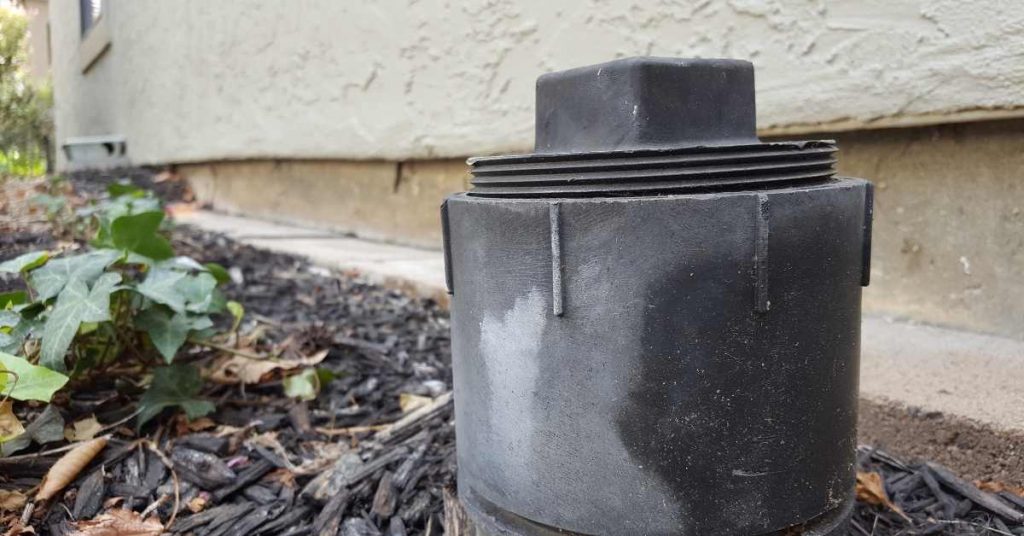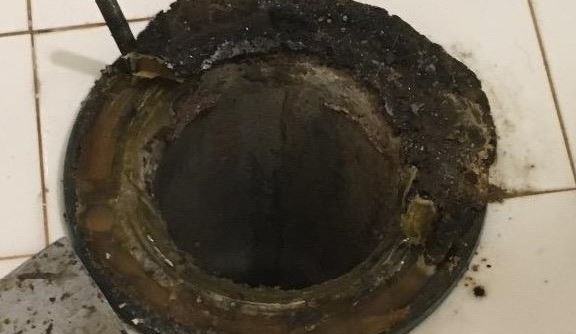
A sewer cleanout is a pipe with a cap/plug that provides direct access to the house’s sewer line to remove blockages and prevent sewer backups. It may be found inside the house or outside but close to the house where it sticks a few inches from the ground and is about 3 to 6 inches in diameter.
There is no standard location for a sewer cleanout. In warmer climates, it will be located outside the house on the lateral sewer line popping a few inches from the ground. Sewer cleanouts in cold climates will be found inside the house connected directly to the main drain stack.
Sewer cleanouts are essential components of a plumbing system, serving as access points to clear clogs, inspect, and maintain sewer lines. Here’s a brief summary of their functions, how to locate them, and potential alternatives:
Functions
- Access Point: Sewer cleanouts provide access to your plumbing system’s main sewer line. This access is crucial for inspecting, clearing blockages, and conducting maintenance.
- Clog Removal: When sewer lines become clogged with debris or tree roots, plumbers can use sewer cleanouts to access and clear the blockage efficiently.
- Inspection: Cleanouts enable plumbers to visually inspect the condition of sewer lines using specialized cameras to identify issues like cracks, leaks, or damage.
Locating Them
- Indoors: In some homes, sewer cleanouts are located in basements, crawl spaces, or utility rooms. They may have a removable cap or access point marked with “cleanout.”
- Outdoors: Outdoor cleanouts are typically found near the home’s foundation or in the yard. Look for round or square caps that are often flush with the ground. They might be marked with “sewer” or “cleanout.”
- Plumbing Plans: Consult your plumbing plans or contact a professional plumber if you’re unsure about the cleanout’s location.
What Does It Look Like?
A sewer cleanout is usually a black or white 4-inch diameter pipe with a screwed-in cap/plug that has a square nut at the top for ease of removal. It will be found popping a few inches from the ground on the lateral sewer line between the house and the street. In colder areas it will be found inside the house.
It is possible to have more than one sewer cleanouts, especially if you have a certain fixture that keeps clogging.
If you have 2 cleanouts, they usually form a U-shape inside the sewer line where one cleanout provides access to the yard while the other provides access to the house. This is a better installation than having to access the sewer line from the plumbing vent or toilet drain
If your house has no sewer cleanout, the sewer line can be accessed through the plumbing vent at the roof of the house or by removing a fixture such as a toilet. Both of these methods are expensive and not ideal but are the only way especially if you have a cast iron sewer pipes.
Sewer cleanouts are installed on the lateral sewers line that connects your house to the septic tank or public sewer system in the street. As such, sewer cleanouts are the responsibility of the homeowner and hence repairs and maintenance costs are met by the homeowner.
On average it will cost between $1000 and $2000 to install a sewer cleanout depending on the difficulty of the work. It costs more if the company has to do extensive digging (especially through concrete) or retrofitting.
Its Diagram
The following a schematic of a typical sewer line with a sewer cleanout outside the house. This diagram is not drawn to scale.

Types of Plumbing Cleanouts
There are 2 main types of plumbing/sewer cleanouts. And they are:
1. One-Way Sewer Cleanout
Majority of sewer cleanouts fall in this category. A one-way sewer cleanout only allow you access to one direction of the sewer system.
If for instance your sewer cleanout is elbowed towards the street, a plumber can only feed their snake or hydro jet toward the yard, between the cleanout plug and the public sewer lines or septic tank.
2. Two-Way Sewer Cleanout
If it looks like you have 2 sewer cleanouts a two-way sewer cleanout is what you have. This type of a sewer cleanout allows you to access both sides of the sewer line.
If the clog is between the cleanout and the street, you will feed the snake/auger in the cleanout elbowed towards the street or septic tank. On the other hand, if the clog is in the house side of the sewer line then you will feed the auger on the cleanout elbowed towards the house.
What you may not be aware is that a 2-way cleanout forms a U-shape with the sewer line. This is what makes it possible to snake both sides of the sewer line.
Do All Homes Have Sewer Cleanouts?

There are 2 questions I often hear being asked about cleanouts.
- Do all homes have sewer cleanouts?
- Should all houses have a sewer cleanout?
All homes/houses should have a sewer cleanout and all new houses do indeed have a sewer cleanout since it is required by the building code. Unfortunately, if you house was built before 1978/80, there is a chance that your house may not have a sewer cleanout.
The thing about sewer cleanouts is that they are not pretty, whether they are located inside the house or outside. As a result, locating them is usually not easy, since they are rarely used as well.
Most people often prefer to hide them behind closets if they are located inside the house or cover them with flower beds if they are located outside the house. Constant mulching and landscaping can also have these pipes completely buried in the yard.
How to Locate a Sewer Cleanout
To accurately locate a sewer cleanout and to do it in the shortest time possible, you will first need to determine if it is located inside or outside the house. Usually, if you live in a cold area, the cleanout will be located inside the house but if you live a warmer area you will find it outside the house.
1. Inside the House
If your sewer cleanout is located inside the house, it will be connected the main drain stack that carries waste from all the fixtures (toilets, sinks, showers and washing machines).
Each fixture in your house has its own drainpipe which is connected to the main drain stack. The main drain stack is then connected to a vertical pipe called a plumbing vent or vent stack, which runs through the roof of the house.
Sewer cleanouts are connected to the main drain stack where they form a Y or T-shape. If you can located the main house drain stack you can locate very easily locate the sewer cleanout.
The location of the plumbing vent on the roof will help you identify the location of the main drain stack since it is usually one vertical pipe. Your bathroom (which has a lot of fixtures) will also be located very close to the main drain stack.
I do not expect to find a sewer cleanout that easily though. It will be concealed inside a closet or under a sink, usually inside a cabinet.
Extend to your search to the utility room, basement or even garage if you cannot find the cleanout in your bathroom. Look for a black or white pipe with a cap which has a square nut at the top.
I can only hope that it is not installed in the crawlspace, which is very big possibility.
2. Outside the House

Locating a sewer cleanout outside the house can be very easy if you know where to look. The good thing is that sewer cleanouts are usually installed very close to the house.
This is done purposefully so that you can remove clogs in your entire length of sewer line between the house and the public sewer line or septic tank.
The first place you will need to look is near the bathroom. Since bathrooms have many water fixtures which are prone to clogging, sewer cleanouts are usually installed very close to them.
Check the area outside your bathroom for a pipe sticking from the ground. If there is a flower bed nearby, there is a good chance that the cleanout is hidden by the flower beds. This is something most people who don’t like the look of cleanouts do.
The other trick you can use is to first answer this question. “Am I on a septic system or a public sewer system”?
If you are on a septic system, walk to where your septic tank is located. If you don’t know the location of your septic tank check out this post.
From your septic tank location, look at where the plumbing vent is on the roof of your house and start walking straight towards the house while looking for the cleanout. You will surely find it somewhere.
If you are connect to the public sewer system, head over to the street and again start walking towards your house. Unless you do not have a sewer cleanout or it is buried in the ground, this method will guarantee you to locate it.
Another thing you can do is to refer to your plumbing diagram which I am sure is in your house inspection report. In fact this can be the fastest way to find your sewer cleanout.
If all your efforts to locate the sewer cleanout bear no fruits, enlist the services of a professional plumber. Plumbers have sophisticated equipment for the same and also have many years of experiencing doing that.
Warning! Never attempt to unscrew your sewer cleanout plug if you have sewer backing up in your house. You have the drain stack full of raw sewage. What will happen if you remove the plug? You property will be overflowing sewage.
What if Your House Has no Sewer Cleanout?
If your house has no sewer cleanout and you need to remove a clog in your sewer line, there are 2 ways you can do to access the sewer line. They are:
1. Through the Plumbing Vent
As I mentioned earlier, a plumbing vent is a vertical pipe that runs through the roof of the house and is connected to the main drain stack.
It removes sewer gases from the drainage system and also introduces air enabling your fixtures to drain faster and toilets to flush better.
2. Remove the Toilet

This is what most plumbers will do since most of them don’t like climbing to the roof of a house. Removing a toilet gives you access to the drain stack but the cost will be more since it involves extra work.
Snaking the sewer line from the toilet drain or via the plumbing vent is not ideal and the success rate is lowered significantly since the snake will take many twists and turns reducing its efficiency.
The plumber will also need to run a camera to examine the type of clog so that they can determine which type of blade to attach to the snake.
What you need to know is that most plumbers will give a guarantee (warranty) if they snake the sewer line from the cleanout. I am however yet to meet one that will give you a warranty after snaking the line from the toilet drain or plumbing vent.
If you have PVC sewer lines, installing a sewer cleanout makes sense and I will encourage you to go ahead and do it. I would however not tell you to do the same if you have old cast iron pipes.
Cast irons pipes will corrode and you will need to install the whole drainage system again. Digging up the yard just to install a sewer cleanout in such a case is not worth it for me. Just wait until you have to repipe your drainage.





